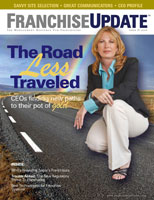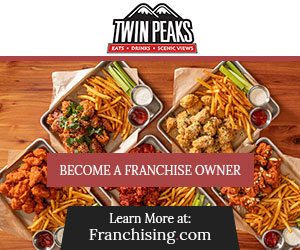Mapping Software in Site Selection
Getting started - early territory development
Franchising could be described as the process of taking one success story and translating and multiplying it into many. Whether through genius or pure luck (usually a combination of both) someone created something that worked once. Naturally, the entrepreneurial thought is; if it worked once it can work again, and again, and again. There begins the seed of the franchising journey that can ultimately lead to great success or unfortunately sometimes great failure. The path to either ending is sometimes determined by the first step taken.
Don't give the farm away
Many things must happen before one can sell a franchise concept and all of them important. However, when the franchisor sells his first franchise, those first tangible steps are critical to long-term success. Because so much is riding on the first few franchisees, there is a tendency to want to maximize and assure success. Early franchising successes greases the skids for additional franchise development. Early success stories make for a much better story.
For franchisors who sell defined territories, one of the easiest ways of assuring success for the first few franchisees is to give them excessively large territory areas. In short, extended territory areas should provide large potential client opportunity which should translate into franchisee success. There is nothing wrong with this action but there are tools readily available that can allow the franchisor to make intelligent decisions that will serve both sides of the table. The fine line that can be achieved using these tools defines a client-rich territory for the franchisee while allowing the franchisor to avoid giving the farm away to assure initial success.
What is best about these tools is that they can provide information that will continually assist the franchisor in adding new territories and franchisees, analyze and rank the next best opportunity for market expansion, and provide a wealth of other assistance, including site selection assistance, target marketing assistance, customer profiling, and assistance in creating a "Where to Begin" starter kit for new franchisees.
The tools
The tools that can help the franchisor "see" his geographic franchising future are geographic information systems (GIS, commonly referred to as mapping software). GIS tools in essence convert spreadsheet or text information (population, house counts, income levels, job occupations, store locations, competitors, territory boundaries, etc.) into live map pictures. Mapping software can stack multiple layers of data together in the same mapped "picture" to allow for analysis of disparate information (e.g., matching store locations to targeted customers, counting how many households with an average income greater than $50,000 are found within a specific franchise territory).
With today's data vendors, the amount and type of data that can be included in the mapping software are unlimited. They includr data items such as SIC Code business data, consumer expenditure data, psychographic consumer data, and traffic count data. Other software tools are available that will geocode data (assign latitude and longitude coordinates based off address information) to add powerful information to a map such as a franchisee's customer locations, other retail locations, and/or competitors.
The point is that these software tools are readily available and make it very easy to assimilate all the information needed to paint the picture required to identify and create equitable, defendable, and successful franchise territories.
Easy as 1-2-3
Nothing is as easy as 1-2-3, but with the right technology, it can come close. A straightforward and logical approach is a series of steps at the start of the development porcess:
1. Identify the customer - this can be as simple as targeting total residential households, or it can as refined as targeting single-parent households with average income greater than $35,000 with at least three children at home. Some franchises are business-to-business services and can identify their customer base by specific SIC Code such as all casual dining restaurants, or businesses with fewer than 20 employees. An operator on the verge of franchising will know its customer base and be able to outline its characteristics. If he doesn't, a study of the existing customer base can be conducted to profile the customer characteristics and provide a detailed description.
2. Define the territory customer count - the next question is how many customers a franchisee will require within his territory to be successful. Determining this count can be subjective but can be based upon the success of the franchisor's original locations. With local market knowledge, the franchisor can estimate the customer base required to be successful. The franchisor can analyze existing locations, determine the customer trade area, and calculate/estimate the total customer base number. This typically will be a population or household count, number of businesses, or some combination of the two. What you need here is to state that each franchise territory should have an X total count of the target customer base.
3. Define the geography - Most franchise territories are created by some "defined" geography such as a group of Zip codes, a radius ring dimension or a user-described area (typically described by following major roads, rivers and other natural barriers). Since all geographic boundaries are readily available including block groups, Zip codes, census tracts, counties, states, DMA's (designated market areas), and MSA/CBSA's (metropolitan statistical area / core based statistical area), these are easily mapped and viewed within a GIS system and are a great foundation for the beginning step in defining territories. Using defined geographic areas (i.e., Zip codes, county boundaries) for territory boundary definitions can save much heartache. Creating boundaries by using these defined areas makes it much easier to communicate the territory dimensions to a franchisee. It can also avoid duplicating or overlapping territory boundaries that can occur if areas are determined solely by roads and barrier descriptions. However, in densely populated metropolitan areas, it may be difficult to use the standard geographic areas, such as Zip codes, as they may contain more customer population than should be found in a given territory. Therefore, smaller user-defined areas are necessary. Fortunately, mapping these areas overcomes any crossover issues.
4. Just map it! - Once you know the target customer, have determined the total customer count needed and have a plan on how to define the territory area, all that is left is to use the mapping tools to find the areas, compute the customer totals and map the territories.
The mapping tools, in conjunction with demographics and business counts, can be a very powerful tool when building territories. The software allows the franchisor to pick Zip codes and combine them into a single territory boundary while totaling the counts as you add or delete additional Zips. The franchise territories are created on the fly, by totaling counts, as you select geography. Having demographic counts associated to map objects allows the user to create "themed" maps by highlighting key data items. For example, the user can theme each Zip code by a color (red to blue equaling hot to cold) based upon the customer target counts within each Zip. The franchisor can immediately "visualize" the hot spots in an area, state or even the whole country.
The mapping software also allows the franchisor to know immediately how many total target customers there are in a market and that will then tell them the total number of reasonable territories that market can hold. The question of "Can this market hold 5 or 15 territories?" is easily and quickly answered. Not only is the question of how many is answered, but the franchisor will know exactly where they should be and how they will look.
OK, how much?
Mapping software is available for all price ranges and needs. The price is dependent upon the level of sophistication, capabilities required and the data needed. Simple mapping objectives can be accomplished within Microsoft MapPoint while MapInfo and ESRI provide more robust GIS software tools. Other service-based consultants offer both software sales and consulting services and can provide a wide-range of solutions to franchisors. Online web-based demographic options also exist with annual subscriptions less than $1,000. On the other side of the scale, custom designed applications with specialty tools can cost thousands of dollars. Any web search for "GIS" or "Mapping Services" will provide a wealth of providers.
Short-term relief = long-term benefits
Facing the task of mapping out the expansion of a new concept can be overwhelming to a franchisor. Fortunately, mapping tools are remarkable aids to the effort. Instead of worrying about a wide expanse of geography, mapping tools literally bring the focus down to the street level, remove confusion and eliminate the pain of getting started. It provides a monumental shift in momentum from being re-active to an opportunity to being pro-active to an opportunity.
Mapping your targeted customer and territory data expedites the process of planning growth. It provides the ability to identify and rank your top ten or top twenty market opportunities. It alters the franchisor growth dynamic from responding to prospective franchisees about where the franchisee wants to be; but instead empowers the franchisor by providing the answers about the critical markets where the franchisor needs to be.
Jeffrey Davis is president of IntelleVue LLC (www.intellevue.com). IntelleVue provides mapping software, demographic analysis and target marketing software tools. Jeff can be reached at 918-250-5561 or [email protected]
Share this Feature
Recommended Reading:
FRANCHISE TOPICS
- Multi-Unit Franchising
- Get Started in Franchising
- Franchise Growth
- Franchise Operations
- Open New Units
- Franchise Leadership
- Franchise Marketing
- Technology
- Franchise Law
- Franchise Awards
- Franchise Rankings
- Franchise Trends
- Franchise Development
- Featured Franchise Stories
FEATURED IN

Franchise Update Magazine: Issue 2, 2006








 The franchise listed above are not related to or endorsed by Franchise Update or Franchise Update Media Group. We are not engaged in, supporting, or endorsing any specific franchise, business opportunity, company or individual. No statement in this site is to be construed as a recommendation. We encourage prospective franchise buyers to perform extensive due diligence when considering a franchise opportunity.
The franchise listed above are not related to or endorsed by Franchise Update or Franchise Update Media Group. We are not engaged in, supporting, or endorsing any specific franchise, business opportunity, company or individual. No statement in this site is to be construed as a recommendation. We encourage prospective franchise buyers to perform extensive due diligence when considering a franchise opportunity.